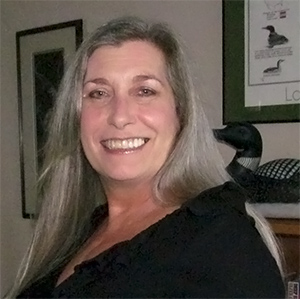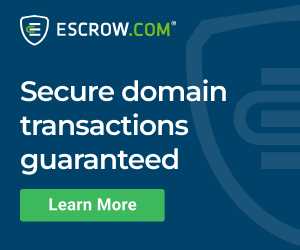
Laurie J. McNeil.
Laurie J. McNeil is an artist and has been a seasoned domain investor for more than 15 years.
In this interview, Laurie talks about the past, present and future of domain investing, sharing with us a few titbits from the ‘old times’ of domaining.
Copyright © 2025 DomainGang.com · All Rights Reserved.DomainGang: Laurie, what was your motivation to become a domainer, versus yet another domain registrant?
Laurie J. McNeil: I registered my first domain names in 1998 for my art business and also for my website development company, back when they were $100 per year, per domain name at Network Solutions.
In late 1999, I registered my first domain name as an investment with the intention of selling at a premium. GADZ.com, a four letter abbreviated word and term of exclamation, similar to “Wow”, Gadz is short for Gadzooks. I happen to use it on a daily basis, and at the time four letter pronounceable .COMs were becoming short in supply. I wanted to register one that meant something to me.
DomainGang: Did you receive plenty of support as a beginner, in the form of educational information? How and where did you find these types of resources?
Laurie J. McNeil: When I began purchasing domain names in 1998, there were no instructional sites for domain name investing. I became a reseller for eNom under BulkDomains.com in 1999, and Beyond Domains transitioned from web development to domain name registrations.
Beyond Domains customer base surged, when it was the first in the market to offer PayPal domain name registrations, for those who did not have credit card capabilities. Until this time, all the big registrars like Network Solutions and even eNom, would only accept credit cards, while there were many who need domains that did not have or use credit cards. These were customers who were being turned away by eNom and other registrars, I saw a niche and filled it by accepting PayPal for domain name registrations.
The commissions generated from Beyond Domains gave me the ability to invest heavily in the domain name drops of the early 2000s. The lists would come in days before the drop, I would do the research to find those domains with built in traffic looking for the services I offered. It would catch the domains I wanted on the drop and convert the traffic to Beyond Domains services. I was able to build Beyond Domains up to over 3000 user accounts over the next few years.
In 2005 registrars finally began integrating PayPal into their own systems and the PayPal niche was no longer in as great demand. Beyond Domains still accepts PayPal for domain registrations and services, even though we are no longer alone in the market. To this day, Beyond Domains has never paid a dime for advertising and it still remains on the first page of Google when “paypal domains” or most “paypal domain registrations” based combos are searched.
DomainGang: How was your first experience interacting with other domain investors?
Laurie J. McNeil: For selling and buying in the aftermarket, Afternic was first, in late 1999-early 2000s. At that time it was a forum website offering a live chat forum. We as domain name “sellers” spent HOURS posting and marketing our domain names for sale in the live chat, hoping for a buyer and discussing domain names as a whole. This was really the only means available to actively sell and purchase aftermarket domain names at the time. I learned quite a bit during those years, and the hours spent were a great investment in knowledge.
I learned how to do the research necessary to determine things like keyword weight, changing search engine algorithms, how to use the search engines to determine other important and key factors in the new names I was going to register. Name drop discussions were where I learned how to find out the amount, and the type of traffic the domain name dropping off experienced, and if it could be converted for my own needs.
The old Afternic was a true community of domainers back in the early 2000’s which I have to credit for much of the knowledge I picked up, early on in my domain name investment business.
DomainGang: What are you investing in, long term? Do you have a preference in holding vs. flipping?
Laurie J. McNeil: Have never really been a “flipper”, so I guess that makes me a “holder”, willing to wait for the end-user if necessary, to get the price I believe the domain name is worth.
Hand registration is my “game”, rather than buying premium. I pay attention to new technologies and trends across many markets, finding excellent .COM one and two word domain names still available, because these are new technologies and trends the mainstream has yet to learn about. Though this tend to take a bit of time.
I did invest in some one word .XYZs as a “universal” extension, which were hand registered during general availability, most of which will be renewed shortly. In addition, I have a few good new gTLDs which I will also be renewing as long-term investments.
DomainGang: What is your position on gTLD domains and investing in them?
Laurie J. McNeil: Not all gTLDs are created equal. Face it, the majority of the new gTLDs are in the English language, and they will mean absolutely nothing to the other potential registrants throughout the world, who speak another language.
It is my thought that there are far too many new “English” gTLDs being offered, for them all to survive. The new gTLDs which target locations outside of the US (.berlin, .tokyo, etc.) and terms in languages other than English (.网址 (web address) or .wang (.net), .haus, etc.), will serve well in their appropriate countries and languages. These new gTLDs have opened up domain names long gone in the English based .COM.
While I do think there is a place for the new gTLDs in the English domain market, it is import to realize the versatile nature of the generic .COM is gone with them. Domains spanning the dot are limited to both sides of the dot working together. Not all words will work with all new gTLDs, and at best should have a single word to left in combination with the new gTLD. These words on either side of the dot must also be in the right order; the way it is said or written in the native language, making them even more limiting.
With so many new gTLDs it is certain; if it’s confusing to experienced domainers, you can bet it will be even more confusing to the rest of the world. At least until they come into their own and begin being used by end-users, instead of held by investors. For these reasons, I feel .COM will remain the cream of the crop as most established and recognized in the world as a whole.
DomainGang: What are some of your best domains, and what makes them special?
Laurie J. McNeil: Synced.com, Synced.net – plus “Synced” in 34 of the best related new gTLDs for brand protection and potential use across multi-markets/platforms.
Hand registered the domain name Synced.com in early 2000, before sync as a word in the dictionary. Short for “synchronized”, the word or term “synced” has become mainstream in everyday vocabulary, necessary to technology, devices, and in many applications, offering great potential to the right developer.
Woodticks.com – Hand registered Woodticks.com in May 2000 because I had just found several woodticks on me that day, early in the season. In 2015, with Tick Borne Disease (TBD), and new cases of diagnosed Lyme Disease and its many co-infections all being caused by woodticks.
Four Letter Domains – GADZ.com, LPSW.com, YNNU.com, USWK.com
I continue to hand register one and two word .COMs weekly, using new technology and trends as my inspiration.
DomainGang: Many thanks, Laurie, for this great trip down memory lane and domain names. Best of success with your current and future ventures!











Laurie, thanks for taking the time to share your experiences. Your story is very inspirational! I think your perspective on the success of gTLDs and the role of .com is spot on. Do you develop any or all of your domains that are for long term investments- including the gTLDs?
Great interview DomainGang! Thanks for sharing.